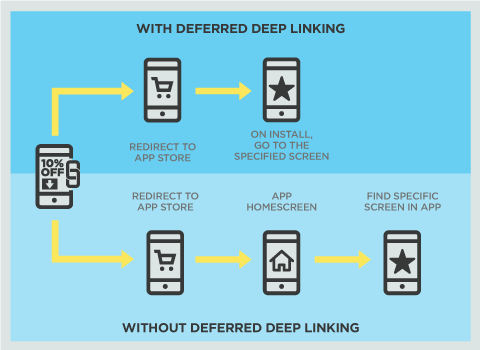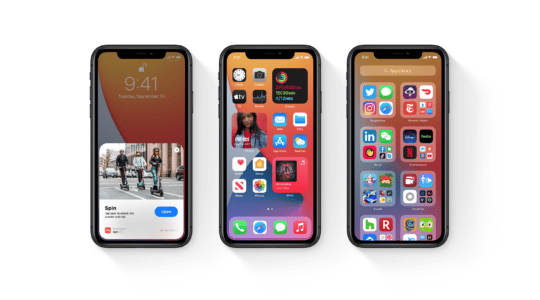Mobile users have largely grown accustomed to the process of clicking on an ad and being redirected to the app store to download an app. However, the user experience and paths to conversion past the install vary significantly depending on the app.
Considering that the cost of a loyal user recently topped $3 and that 20% of apps are used just one time, it’s essential for mobile marketers to deliver a stellar experience to first-time users.
Deferred deep linking plays a major role in this objective.
Deep linking basics
In order to understand why deferred deep linking is important, it’s helpful to understand the basics of standard deep linking. Mobile apps do not inherently include the linkable functionality that we take for granted when using a traditional browser (i.e. in a browser we can link any page on any website to any other page on any other site). A standard deep link serves a purpose similar to a URL on a website – it enables specific screens or states deep within apps to be linked to directly.
In the past, links from one app or the mobile web were only able to send users to the home screen of a different app. Users would then have to search, browse, and hopefully navigate to the intended screen. But by utilizing deep links, users can bypass the home screen and be linked directly to the most relevant screen in the app, creating a far more streamlined user experience.
The one drawback to standard deep links is that users must already have the app installed on their device in order for the links to be effective. If a deep link is clicked and the app is not installed, users will be directed to the app store and then to the app home screen, creating the undesirable, friction-filled experience of having to navigate an unfamiliar app looking for a specific screen.
Deferred deep linking
Deferred deep links are designed to enable first-time app users to receive the optimized user experience afforded by deep links. This empowers marketers to dramatically reduce friction to conversion and deliver a far superior first-time experience. To illustrate how deferred deep linking works, consider a basic example:
Suppose a marketer for a retail app ran a paid campaign offering a 10% discount on a popular item. Based on whether or not deferred deep linking is being utilized, the user’s path to the conversion will take one of two routes:
With deferred deep linking: When a user clicks on the ad, the deferred deep link redirects them to the appropriate app store (i.e. Google Play, App Store) based on the user’s operating system. After the app has been installed, the user is automatically directed to the screen deep within the app featuring the popular item at the discounted price. The user can then continue on the conversion path and make the purchase.
Without deferred deep linking: When a user clicks on the ad, they are redirected to the appropriate app store. After downloading the app the user is then sent to the app home screen where they have to navigate the app and hopefully find the specified screen at the discounted price. Assuming they were able to successfully find the product, the user could then continue on the conversion path and complete the purchase.
The additional step of requiring users to navigate the app may seem subtle to some, but when you compare the two user experiences (being sent directly to the intended screen vs. browsing menus, searching the app, etc.) the difference is quite substantial.
The retail scenario above is one of the most common use cases for deferred deep linking. Examples of how deferred deep links can be used in other verticals include:
- Travel: An app offering hotel deals might run a paid search campaign. When a user searches for “hotels in Seattle” they would see an ad for the travel app. After clicking on the CTA the deferred deep link would direct the user to the app store. Following the install the user would then automatically be sent to a specified screen deep within the app featuring hotel deals in Seattle.
- Entertainment: A music app might run an ad on Twitter featuring a top artist. When the user clicks on the link and installs the app, the deferred deep link would send the user to the app store, then directly to the screen in the app with music by the featured artist.
- Business/Productivity: A cloud storage app might use deferred deep links as part of a referral program. For example, an existing user could send their friends an SMS message with a link promoting the cloud service app. When a friend clicks on the offer, the deferred deep link would take them to the app store, and then directly to a dynamic screen within the app with a personalized message (e.g. Hi Peter! Lucas referred you to Cloud Storage. Create an account and you’ll both receive a $25 credit.)
These examples highlight just a few of the ways deferred deep linking can be utilized across a variety of verticals.
Key benefits of deferred deep linking
As illustrated in the scenarios above and alluded to throughout this article, the key benefits of deferred deep linking include:
Minimizing friction to conversion: Minimizing friction to conversion is a constant priority for mobile marketers and a critical component of successful user acquisition. Instead of dumping new users at a home screen and expecting them to successfully navigate an unfamiliar app, deferred deep linking connects users to the exact screen of interest, enabling them to easily complete a purchase or other desired outcome.
Improving the user’s first-time experience: With unnecessary steps in the conversion path removed, the user is far more likely to have a successful first-time experience with your app. A positive first experience can directly influence whether or not a user returns to your app a second time or responds to your re-engagement efforts. In addition, it can heavily influence how users rate your app in the app store.
Deferred deep linking also simplifies your job as a mobile marketer. Through a single link you can deliver an optimized experience to new users that mirrors the experience you provide to your existing users.
Implementing deferred deep links in your apps
If you need to brush up on deep linking basics, this webinar and white paper will help.
In summary
Building and maintaining an active and engaged user base is challenging and increasingly costly endeavor. As you work to optimize user acquisition, deferred deep linking can be an extremely valuable tool that enables you to minimize the friction to conversion and improve the user’s first experience with your apps.
Have you had success utilizing deferred deep linking with your apps? Let us know in the comments below.
Author
Becky is the Senior Content Marketing Manager at TUNE. Before TUNE, she led a variety of marketing and communications projects at San Francisco startups. Becky received her bachelor's degree in English from Wake Forest University. After living nearly a decade in San Francisco and Seattle, she has returned to her home of Charleston, SC, where you can find her enjoying the sun and salt water with her family.





Leave a Reply
You must be logged in to post a comment.